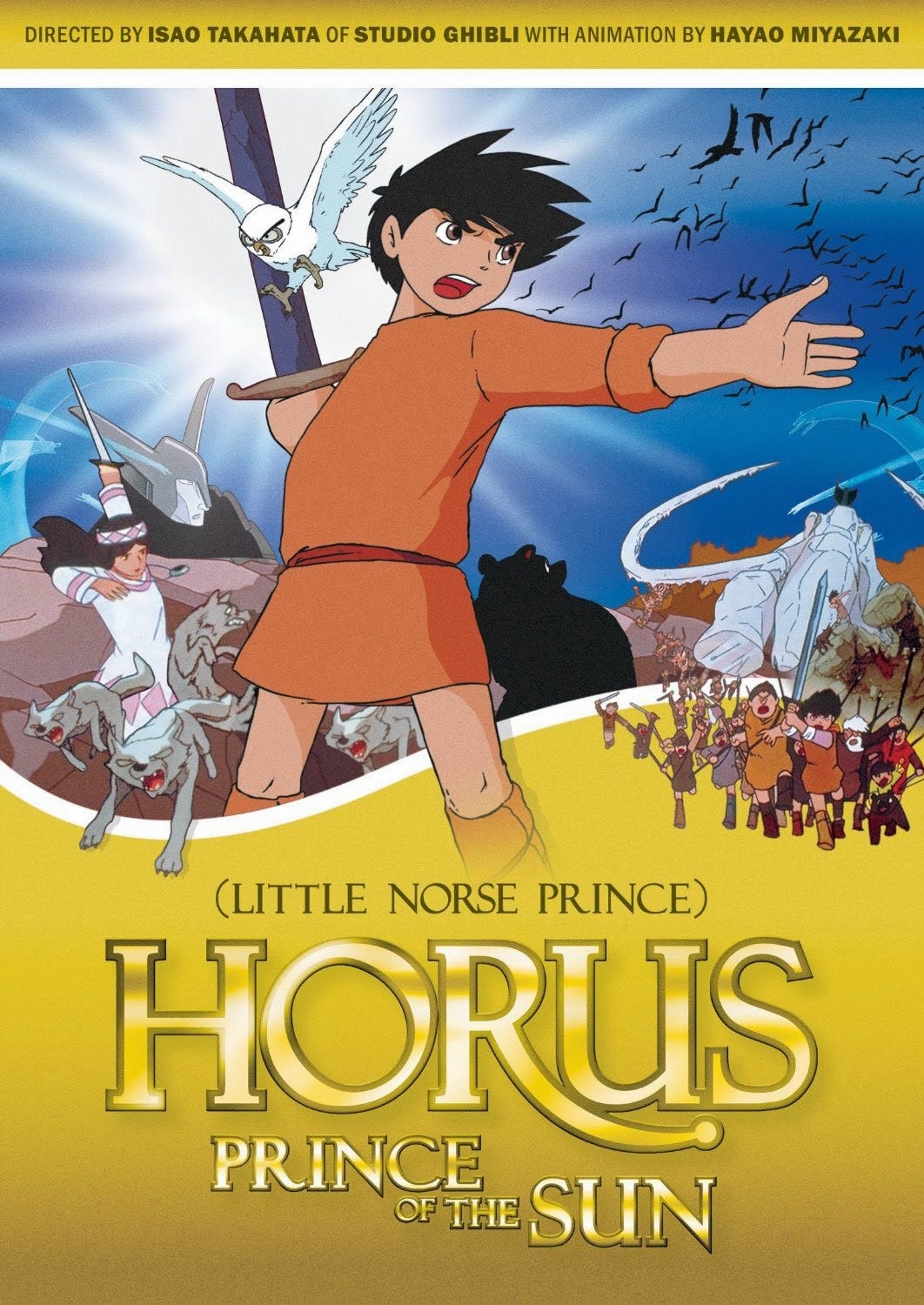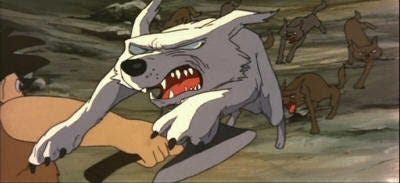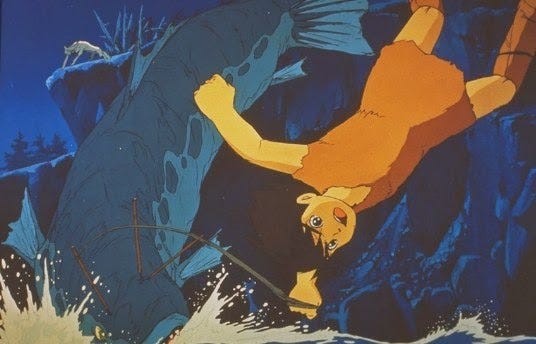Celebrating the landmark impact of Isao Takahata's "Horus, Prince of the Sun" and a wonderful new DVD release

If you are a fan of Isao Takahata, Hayao Miyazaki, or Studio Ghibli, or of animation in general, or Japanese cinema on the whole, or even world film history in its broadest strokes, there is no DVD in recent times more important and revelatory than Discotek Media’s release of Horus, Prince of the Sun.
The film, a Toei animated feature from 1968, was the feature directorial debut of Takahata – who would go on to craft such landmarks as Grave of the Fireflies and the recent, Oscar-nominated The Tale of Princess Kaguya – and was animated by a team of soon-to-be giants including, but certainly not limited to, Hayao Miyazaki. Were it merely the inception point of so many significant careers, the film would certainly deserve some attention, but Horus is so much more than that. As Daniel Thomas MacInnes argues on one of the disc’s two audio commentaries, Horus may well be Japanese animation’s Citizen Kane, the defining moment in which ‘anime’ transcended the limitations of Western influence and proved itself a force of intense artistic and intellectual power.
I had heard of the film many times before, a constant fixture in research I have done on Takahata and Miyazaki; yet until Discotek’s recent DVD release – which arrived at the tail-end of 2014, with minimal attention or fanfare – I had never had the chance to see it, for this is the first time Horus has been made commercially available in the United States. It is a cause for immense celebration. This is a jaw-dropping film, a stunning work of radical power and unbridled cinematic passion that remains a wonder to behold 46 years after its theatrical release. To watch it is to see the history of modern anime unfold; all the potential of Isao Takahata, Hayao Miyazaki, and the industry as a whole is contained within Horus’ brief yet dense 82 minutes, and now that I have seen it, it is clear to me that no appraisal of either man’s careers, let alone the last five decades of Japanese animation, can be undertaken without seeing and discussing Horus. It is that sort of milestone, and to finally see it is like uncovering a long-buried treasure.
That this film has finally been brought to North American audiences is significant no matter what, but the work done by Discotek on this release is so exemplary that I feel it warrants further attention. With terrific video quality and a thoroughly researched, expertly compiled slate of extras, Discotek has crafted a DVD package worthy of the film’s underexplored legacy. It is easily one of the most exhilarating and essential home video releases I have come across in months, from any corner of the cinematic world, and since I have barely seen the DVD discussed online, even in places I should think might highlight it, I wanted to take the time to talk about this release in some detail. It truly is an invaluable archive.
Continue reading after the jump…

The Great Adventure of Horus, Prince of the Sun (as it is titled in full) is one of those historical landmarks that still feels palpably radical, even many decades later. At this point in the industry’s history, Japanese animation was still bound by the conventions of American animation, Walt Disney in particular, as it was the world’s only model of broadly successful commercial animation. This was the context in which Takahata and company were working, and with the animation itself bearing vestiges of Disney – the simple, clean line-work of American animation had yet to give way to the more angular and detailed look we are used to in Japanese animation – and with the many anthropomorphized animals and songs on display, one might be forgiven for thinking Horus a Western film at first glance, or at least a relic of Japanese animation before it came into its own. Yet what constantly fascinates me about the film – what really feels radical and revolutionary – is how Takahata keeps subverting those traditions, or using them to entirely different ends, and doing so with such artistic passion and intelligence that a new artistic model is born before our eyes.
So we have our unflappable male hero, but he’s drenched in violence and conflict from beginning to end, the line of his ‘destiny’ mired in such dense strands of human doubt and fallacy that there is nothing ‘simple’ about his morality or evolution. We have an imposing antagonist with plans for domination, yet here, he is literally the ‘devil’ (an akuma), a force of pure evil and corruption, and facing him means the film directly confronts the nature and psychological toll of violence and death. There are indeed talking animals, and while they can be cute and inviting presences, they too exist as part of this traumatic world too (as Takahata points out in a supplemental interview, the creatures work more as visual extensions of human psyche than they do comic relief foils). There are songs, but they serve to accentuate tone, and evoke cultural atmosphere, and they are so much more emotionally and textually complex than what they appear on the surface. There is action and adventure, but it’s brutal, terrifying even, Takahata setting an important precedent that violence and death mean something, and cannot be taken for granted.

Most importantly, we have a female co-lead, one who is beautiful and prone to singing, yet she is far from the simple window dressing featured in Western animation. Hilda is complex, a demon child wracked with confusion over whether she should walk the path of mankind, and be party to their mortality and flaws, or live above them, removed from the chaos as an immortal, elevated demon. Her psychological turmoil is never simplified or treated anything less than seriously – she is the film’s thematic touchstone, and in her creation is sown the seeds for every great female protagonist Takahata and Miyazaki would ever create; perhaps even the whole rich history of psychologically vivid and complex characters, both male and female, in Japanese animation.
And yet, these are all perhaps the simplest elements of Horus to take apart and digest. When the film dives into more fully experimental territory, as it does late in the story when Horus is sent into a dimension of doubt, the film unshackles itself from all convention, animated or otherwise; there are times, watching the film, where my mind reels considering this could have been made in 1968 at all, anywhere in the world, yet alone in the realm of Japanese animation. Then there are the influences from live-action world cinema Takahata employed here; his love of the French New Wave especially is worn on the film’s sleeve, especially in the film’s wholly unusual, and undeniably invigorating, widescreen composition, or in the dynamic camera movements glimpsed throughout.
The film’s conclusion is an act of cinematic revolution in and of itself, as Takahata and company push the story into the realm of political allegory, turning Horus’ archetypal adventure into an analogue for the worldwide turmoil of the 1960s in general, and the labor disputes of Toei animation in specific (Takahata, Miyazaki, and many of the film’s animators were leaders in the labor union at Toei, a series of conflicts that would push Toei to pull Horus from theatrical release after just 10 days, and would soon force most of its creators from the studio entirely). There is a palpable bravery to the conclusion, a passion to the film’s unrepentant socialist message of people coming together to fight against the opposition of the individual, that resonates powerfully even to this day.
I am, again, amazed to consider that Takahata and his team got away with any of this. Horus was a statement, an announcement of a wide swath of major talents working tirelessly to prove themselves. Everything about the film’s existence amazes me – that it was directed and created by such young, untested artists; that it pushed boundaries as far it did, in as many ways as it did, at the time it was made; and of course, that those responsible for its creation would only go on to improve from here, building on this foundation to do nothing less than transform the face of cinema. This is a film we should speak of in the same tones as the initial works of the French New Wave, or of Italian Neorealism, or any other major paradigm shift in the history of world cinema. Like those works, Horus took what previously existed and redefined ‘convention’ in so many different ways; it was the start of something big, and stands as an essential cinematic text.

There is always the danger of hyping a film like this too much, of course, and I think it is worth acknowledging that there are awkward, unfinished qualities to the film. I do sense some discomfort in the use of various Western elements, as if the animals or songs don’t always feel fully integrated, or the film stylistically yearns, at times, to break free even further. The animation is stunning for the time, taking major leaps forward in background detail, character design, and fluid motion, but less so by the standards these animators would later set, and there is a whole battle sequence in the middle that is effectively unfinished (and yet the film is even influential in that regard – substituting an unfinished sequence with dynamic still frames remains a solution for low-budget or hurried anime productions to this day). Horus is not, all things being equal, necessarily the equal of Takahata or Miyazaki’s later masterpieces, and I do think parts of it will be difficult for some viewers to access today; works from this period of Japanese animation are so rare to encounter in the first place, and seeing one that straddles the line between past and future as completely as Horus does is a challenging experience.
And yet Horus is still so engaging, on so many levels, so haunting and beautiful and deep and accomplished, that it cannot be ignored; and when viewed in its historical context, the film is as staggering and astounding as they come. It puts something like The Tale of Princess Kaguya in even greater focus for me; for Takahata to go from Horus to Kaguya in fifty years, starting his career with a major paradigm shift and abandoning convention altogether by the end, pushing his style and content to a point of experimental poetry, is an astounding evolution for any director to make; in truth, anime as a whole (including towering masters like Miyazaki himself) followed him along the way. That one man could have these two works to his name boggles the mind; that so many other major figures, like Miyazaki, were there at the start of this revolution is equally astounding. But as I said, that’s true of everything about Horus. It’s quite the discovery.

And Discotek really couldn’t have done the film any better here, short of giving it the full Blu-ray treatment (though I in no way bemoan them going DVD only, as I imagine it was the only way to make this release commercially viable). The film looks gorgeous here, perfectly mastered from a shockingly clean, intact source (given Japan’s reputation for poor cinematic preservation, visual quality is never certain with films of this vintage), and it sounds great as well (again considering the film’s age). The new English subtitle translation is fantastic, faithful and expressive in equal measure, and it comes with the requisite English dub track as well, if you want to make your ears bleed from awkward, unnatural line deliveries and a severely degraded audio mix.
This top-notch presentation of the film itself would of course be enough – especially for such a reasonably priced release – but the supplemental package Discotek has curated is an embarrassment of riches, especially when compared with most other anime home video releases. Two full audio commentaries are provided, both well-researched from knowledgeable enthusiasts; the second may not be a recording of professional quality, but the content is great nevertheless. There are two video interviews, one with animator Yoichi Kotabe, a major figure from this era who shares excellent insight into the creation of Horus, and one with director Isao Takahata, which is a rare, supremely informative treat indeed. To hear him talk about the turmoil that went into making the film, or discuss in such depth the inspirations he took from other films and movements around the world, is a joy, and I am ecstatic that Discotek uncovered and translated the conversation.
Apart from the film’s original Theatrical Trailer – also presented with excellent A/V quality – the rest of the extras are text-based, and while it might have been nice to have these offered as a physical booklet rather than on-screen text, I understand budgetary limitations would have probably made that difficult, and am happy to have it all either way. There is a gallery-esque feature that explores all the ways Horus inspired later moments in Takahata and Miyazaki’s career, as well as anime at large, and also considers the works that inspired Horus itself. Daniel Thomas MacInnes, who also provides one of the two audio commentaries, offers an analytical essay about the characters of Hilda and Horus, and there is an additional archival interview with Isao Takahata as well. To my mind, the most revelatory feature on the disc is a tribute to Reiko Okuyama, an incredibly influential female animator from this period whose name will likely be unfamiliar to most viewers (mine included); learning about her contributions not only to Horus, but to the industry at large – especially women’s rights in the animation industry – is fascinating, and provides even greater context for the radical politics of the film itself. All of these text-based features are thoroughly researched and informative; my only wish is that they had taken another editorial pass on all of them, as each is distractingly filled with easily-fixable typos.

Nevertheless, Discotek has put together something really special here. This release is just a great piece of film archiving, collecting supplements from around the world and creating new ones to fill in the gaps. In offering such thorough analysis of the film in question, the disc manages to feel like a ‘film school in a box,’ that sweet spot always aimed for by the Criterion Collection, where one can learn so much about the film and its context right alongside an expert presentation. And it is a dirt-cheap release to boot. There is nothing here not worth celebrating, and no excuse not to buy, explore, and discuss this milestone release. I could not possibly recommend it any more passionately, and alongside other early Takahata and Miyazaki projects Discotek has gradually been releasing (they also recently released Miyazaki’s 1st film, The Castle of Cagliostro, alongside TV series like Lupin the 3rd and Sherlock Hound), it’s clear to me this company is doing some pretty impressive, important work in anime archiving. I look forward to whatever comes next.
Horus, Prince of the Sun is available from Discotek Media at various retailers, including Amazon, where it currently sells for $17.99. That is an insanely low price for such an essential purchase.

